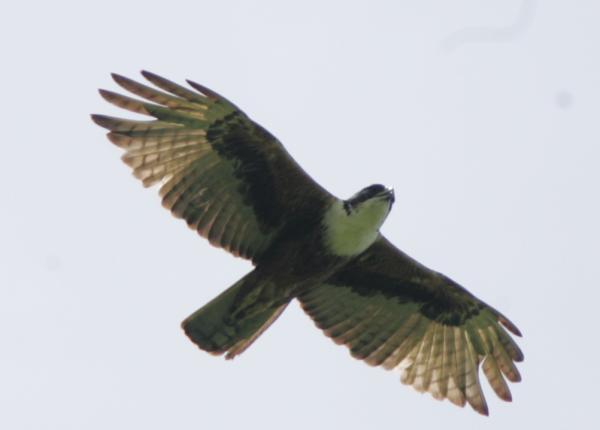Did you know?
- Up until as recently as 2016, the Rufous-bellied Eagle was listed as Least Concern by the IUCN. However, due to drastic loss of habitat throughout its range, it is now considered Near Threatened
- There are two recognizes subspecies of the Rufous-bellied Eagle
- This species is known by several other names including Chestnut-bellied Eagle, Rufous-bellied Dwarf Eagle, and Rufous-bellied Hawk-eagle
How The Peregrine Fund is Helping
Though the Peregrine Fund is not working directly with Rufous-bellied Eagle, our conservation efforts through habitat protection, education, and community outreach extend to all raptor species, including this beautiful eagle. We also supply literature to researchers from our avian research library, which helps scientists around the world gather and share important information on raptor conservation.
Where They Live
The Rufous-bellied Eagle is found throughout much of Asia's tropical forests. It lives in parts of India, Sri Lanka, Bhutan, Nepal, Bangladesh, Myanmar, Philippines, Brunei Darussalam, Cambodia, China, Indonesia, Malaysia, Thailand, Vietnam and Sumatra, just to name a few countries where it makes its home. It is mainly a low to midland species, spending its time perching, roosting, hunting and otherwise going about its day from sea leavel to around 2,000 meters (6,560 feet) above sea level.
The Rufous-bellied Eagle makes can be seen in a plethora of different habitats including evergreen and mixed forests, disturbed forest, and forest edges, occasionally ranging over slopes and nearby open areas.
What They Do
The Rufous-bellied Eagle is a beautiful bird of prey that has a very distinctive plumage. The adult Rufous-bellied Eagle has a black head, which makes it look like it is wearing a helmet or a mask. As you can imagine based on its name, it also has a rusty-orange, or rufous belly! This makes a startling contrast with the mottled white on its breast and throat. Like the Ornate Hawk-eagle, the Rufous-bellied Eagle's legs (or tarsi) are fully feathered.
Like with many raptor species, the female Rufous-bellied Eagle is larger than the male. She will also have a bit more black on her face.
The Rufous-bellied Eagle can be seen perching on horizontal branches just below the canopy above forested hillsides and valleys, however it is known to spend a lot of time soaring over forest slopes and hills, either by itself or with one other eagle. In this case, it is usually an adult its offspring.
This beautiful eagle apparently doesn't vocalize much outside of breeding season. But, when it does call, it makes a high-pitched noise sounding like "keeee" very often while in flight, or a series of shorter calls that sound almost like whistles, which it might use to communicate with its mate.
Why They Need our Help
Though the Rufous-bellied Eagle is considered a common species in many parts of its range, scientists believe that its populations are probably declining in some areas as a result of massive deforestation events. There is a small ray of hope, however. Based on observed nest locations, it appears that the Rufous-bellied Eagle may actually be able more tolerant of some amount of forest disturbance than previously thought.
What They Eat
Imagine observing a party of green pigeons, happily feeding in the canopy with other pigeons. Suddenly there is a loud crash, the tree shakes and you see a Rufous-bellied Eagle coming at full speed through the foliage! That would be an amazing sight to see and one lucky researcher did just that!
Apart from feeding on medium-sized birds, like the pigeons, as well as Black-billed Koel, domestic fowl, Pacific Golden Plover, Black-capped Kingfisher, minivets, swallows and swiftlets, it also feeds on small mammals, such as squirrels, and reptiles.
As you might imagine from the story above, the Rufous-bellied Eagle doesn't mess around when it comes to a meal. It captures its prey in a swift, diving flight, often stooping at incredible speeds to catch birds in mid-air. However, it is a powerful hunter even when not on the wing. It can also snatch its prey from the ground or from treetops.
Nests, Eggs and Young
Scientists actually know very little about the breeding and nesting behavior of the Rufous-bellied Eagle! One lucky researcher was able to observe a male breaking off large sticks from trees and placing them on the nest structure, so we know the males play a part in nest building. We also know that the male and female do share some of the incubation duties, and both help feed and care for their young. Here is what we also know: the Rufous-bellied Eagle builds a large stick nest, lined with green leaves, which it places in tall trees, and the female may lay only one egg in a breeding season. We also know that in some parts of its range, breeding season lasts from December to March, though this can vary. And that is it! We don't know how many days the eggs need to be incubated, or how long the fledgling might stay with its parents before dispersing.
The Rufous-bellied Eagle would be a great subject of study for a young biologist interested in birds of prey!
Rufous-bellied Eagle and The World Center for Birds of Prey
The World Center for Birds of Prey offers fun ways to learn about raptors. Interactive activities, tours, interesting videos and a children's room with activities from coloring sheets and quizzes to costumes and a touch table are available for the curious mind. We also have several different birds of prey on display year-round. Come for a visit, where our knowledgeable staff and volunteers are on hand to answer any questions you may have about Rufous-bellied Eagles or other raptors.
Global Raptor Information Network. 2022. Species account: Rufous-bellied Eagle Lophotriorchis kienerii. Downloaded from http://www.globalraptors.org on 25 Oct. 2022










